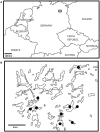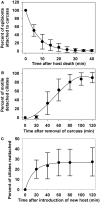Ciliate epibionts associated with crustacean zooplankton in german lakes: distribution, motility, and bacterivory
- PMID: 22783247
- PMCID: PMC3389611
- DOI: 10.3389/fmicb.2012.00243
Ciliate epibionts associated with crustacean zooplankton in german lakes: distribution, motility, and bacterivory
Abstract
Ciliate epibionts associated with crustacean zooplankton are widespread in aquatic systems, but their ecological roles are little known. We studied the occurrence of ciliate epibionts on crustacean zooplankton in nine German lakes with different limnological features during the summer of 2011. We also measured the detachment and re-attachment rates of the ciliates, changes in their motility, and the feeding rates of attached vs. detached ciliate epibionts. Epibionts were found in all lakes sampled except an acidic lake with large humic inputs. Epibiont prevalence was as high as 80.96% on the cladoceran Daphnia cucullata, 67.17% on the cladoceran Diaphanosoma brachyurum, and 46.67% on the calanoid copepod Eudiaptomus gracilis. Both cladoceran groups typically had less than 10 epibionts per individual, while the epibiont load on E. gracilis ranged from 1 to >30 epibionts per individual. After the death of the zooplankton host, the peritrich ciliate epibiont Epistylis sp. detached in an exponential fashion with a half-life of 5 min, and 98% detached within 30 min, leaving behind the stalks used for attachment. Immediately after detachment, the ciliates were immotile, but 62% became motile within 60 min. When a new host was present, only 27% reattached after 120 min. The average measured ingestion rate and clearance rate of Epistylis were 11,745 bacteria ciliate(-1) h(-1) and 24.33 μl ciliate(-1) h(-1), respectively. Despite their high feeding rates, relatively low epibiont abundances were observed in the field, which suggests either diversion of energy to stalk formation, high metabolic loss by the epibionts, or high mortality among the epibiont populations.
Keywords: Epistylis; bacterivory; ciliate epibionts; crustacean zooplankton; epibiont motility.
Figures






Similar articles
-
Protistan epibionts affect prey selectivity patterns and vulnerability to predation in a cyclopoid copepod.Sci Rep. 2022 Dec 31;12(1):22631. doi: 10.1038/s41598-022-26004-5. Sci Rep. 2022. PMID: 36587046 Free PMC article.
-
Spatial and temporal patterns in the occurrence of peritrich ciliates as epibionts on calanoid copepods in the Chesapeake Bay, USA.J Eukaryot Microbiol. 2005 May-Jun;52(3):236-44. doi: 10.1111/j.1550-7408.2005.00025.x. J Eukaryot Microbiol. 2005. PMID: 15927000
-
Container volume may affect growth rates of ciliates and clearance rates of their microcrustacean predators in microcosm experiments.J Plankton Res. 2021 Mar 17;43(2):288-299. doi: 10.1093/plankt/fbab017. eCollection 2021 Mar-Apr. J Plankton Res. 2021. PMID: 33814976 Free PMC article.
-
New records for associations between peritrich protozoan ciliates (Ciliophora, Sessilida) and polychaete worms (Annelida) from off the southeastern coast of India.Zootaxa. 2021 Nov 25;5071(4):492-504. doi: 10.11646/zootaxa.5071.4.2. Zootaxa. 2021. PMID: 35390897 Review.
-
[Non-predatory mortality of the crustacean zooplankton and its possible causes (a literature review)].Zh Obshch Biol. 2009 Mar-Apr;70(2):168-92. Zh Obshch Biol. 2009. PMID: 19425353 Review. Russian.
Cited by
-
CARD-FISH and prey tracer techniques reveal the role of overlooked flagellate groups as major bacterivores in freshwater hypertrophic shallow lakes.Environ Microbiol. 2022 Sep;24(9):4256-4273. doi: 10.1111/1462-2920.15846. Epub 2021 Dec 21. Environ Microbiol. 2022. PMID: 34933408 Free PMC article.
-
Universality of human microbial dynamics.Nature. 2016 Jun 9;534(7606):259-62. doi: 10.1038/nature18301. Nature. 2016. PMID: 27279224 Free PMC article.
-
The eukaryome of modern microbialites reveals distinct colonization across aquatic ecosystems.NPJ Biofilms Microbiomes. 2024 Sep 3;10(1):78. doi: 10.1038/s41522-024-00547-z. NPJ Biofilms Microbiomes. 2024. PMID: 39227595 Free PMC article.
-
Diversity and Distribution of Peritrich Ciliates on the Snail Physa acuta Draparnaud, 1805 (Gastropoda: Physidae) in a Eutrophic Lotic System.Zool Stud. 2018 Oct 17;57:e42. doi: 10.6620/ZS.2018.57-42. eCollection 2018. Zool Stud. 2018. PMID: 31966282 Free PMC article.
-
Molecular and functional ecology of aquatic microbial symbionts.Front Microbiol. 2013 Mar 15;4:59. doi: 10.3389/fmicb.2013.00059. eCollection 2013. Front Microbiol. 2013. PMID: 23509443 Free PMC article. No abstract available.
References
-
- Borror A. C. (1968). Ecology of interstitial ciliates. Trans. Am. Microsc. Soc. 87, 233–24310.2307/3224447 - DOI
-
- Cabral A. F., Dias R. J. P., Utz R. P., Alves R. G., D’Agosto M. (2010). Spatial and temporal occurrence of Rhabdostyla cf. chironomi Kahl, 1933 (Ciliophora, Peritrichia) as an epibiont on chironomid larvae in a lotic system in the neotropics. Hydrobiologia 644, 351–359
LinkOut - more resources
Full Text Sources

